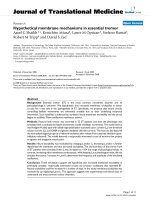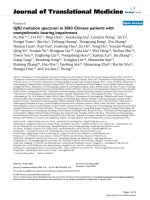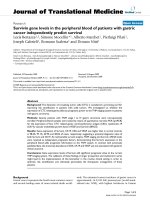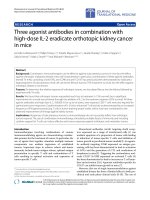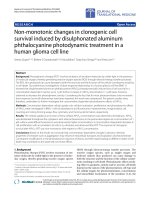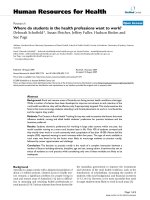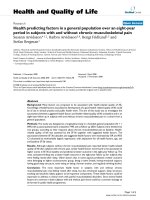báo cáo hóa học: " Work-related musculoskeletal disorders in the automotive industry due to repetitive work implications for rehabilitation" docx
Bạn đang xem bản rút gọn của tài liệu. Xem và tải ngay bản đầy đủ của tài liệu tại đây (374.1 KB, 6 trang )
RESEARC H Open Access
Work-related musculoskeletal disorders in the
automotive industry due to repetitive work -
implications for rehabilitation
Michael Spallek
1*
, Walter Kuhn
1
, Stefanie Uibel
1
, Anke van Mark
2
, David Quarcoo
1
Abstract
Background: Musculoskeletal disorders (MSDs) due to repetitive work are common in manufacturing industries,
such as the automotive industry. However, it’s still unclear which MSDs of the upper limb are to be expected in
the automotive industry in a first aid unit as well as in occupational precaution examinations. It is also unclear
which examination method could be performed effectively for practical reasons and under rehabilitation aspects.
Additionally, it was to discuss whether the conception of unspecific description for MSDs has advantages or
disadvantages in contrast to a precise medical diagnosis.
Methods: We investigated the health status of two study populations working at two automotive plants in
Germany. The first part included 67 consecutive patients who were seen for acute or chronic MSDs at the forearm
over a 4-month period at the plants’ medical services. Information about patients’ working conditions and
musculoskeletal symptoms was obtained during a standardized interview, which was followed by a standardized
orthopedic-chiropractic physical examination. In the second part, 209 workers with daily exposure to video display
terminals (VDT) completed a standardized questionnaire and were examined with function-oriented muscular tests
on the occasion of their routine occupational precaution medical check-up.
Results: The majority of the 67 patients seen by the company’s medical services were blue-collar works from the
assembly lines and trainees rather than white-collar workers from offices. Rates of musculoskeletal complaints were
disproportionately higher among experienced people performing new tasks and younger trainees. The most
common MSD in this group were disorders of flexor tendons of the forearm. By contrast, among the 209
employees working at VDT disorders of the neck and shoulders were more common than discomfort in the
forearm. A positive tendency between restricted rotation of the cervical vertebrae and years worked at VDT was
observed. In addition, only less than 8% of unspecific disorders of the upper limb (esp. wrist and forearm) were
found.
Conclusions: Functional tests for the upper limb seemed to be very helpful to give precise medical advice to the
employees to prevent individual complaints. The results are also helpful for developing specific training programs
before beginning new tasks as well as for rehabilitation reasons. There’s no need to use uncertain terminology
(such as RSI) as it may not be representative of the actual underlying disorders as diagnosed by more thorough
physical examinations.
* Correspondence:
1
Institute of Occupational Medicine, Charité-Universitätsmedizin Berlin, Free
University Berlin, Humboldt-University Berlin, Thielallee 69-73, 14195 Berlin,
Germany
Spallek et al . Journal of Occupational Medicine and Toxicology 2010, 5:6
/>© 2010 Spallek et al; licensee BioMed Central Ltd. This is an Open Access article distributed under th e terms of the Creative Commons
Attribution License ( which permits unrestrict ed use, distribution, and reproduction in
any medium, provided the original work is properly cited.
Introduction
The increased automation of the car manufacturing pro-
cess, in which much of the assembly has been delegated
from man to machine, has done much to relieve work-
ers the burden of heavy lifting [1]. However, despite
ergonomic improvements in the workplace, many jobs
still require workers to perform repetitive tasks [2,3].
Investigations into the health aspects of repetitive work
have demonstrated some years ago the prevalence of
uns pecific diagnosis (for example “repetitive strain inju-
ries” RSI) has been increasing in different countries
around the globe [4,5]. Other sectors of the workforce,
especially those working in offices at video display term-
inals (VDTs), have also been reported to suffer from
work-related problems [6]. VDT-work, such as data-
entry, can cause disorders of the wrist and forearm,
especially in poorly designed workspaces [7-10].
The main objective of this two-part study was to
determine the type of upper limb musculoskeletal disor-
ders (MSDs) among both blue-collar (assembly line, trai-
nees) and white-collar (office) workers in large
automotive manufacturing plants. A secondary objective
was to relate the individua l disorders to the results of
the functional examinations and, if possible, to type of
repetitive work they perform. It was also of interest
whether functional testing can be helpful in developing
individual training or re habilitation programs. Addition-
ally, it was of interest whether the conception of unspe-
cific descriptions for MSDs in the upper extremity has
advantages compared with functional-oriented muscular
tests and developing a precise medical diagnosis.
Participants and Methods
Participating Institutions
Workers from two automotive manufacturing plants in
Germany participated in this study. Plant A assembled
gearboxes and small servic e parts for two G erman car
manufacturers, plant B manufactured light duty vehicles
and small passenger busses. Both plants employed roughly
15,000 workers each, only a quarter of whom were white-
collar workers. Trainees comprised approximately 5% of
the workforce in both plants. Blue-collar work included
repetitive tasks such as assembling product, co nnecting
cables, polishing metal and drilling (Plant A) respectively
working in a press shop, body sho p or car assembly lines
(Plant B). All participants provided informed consent.
Data collection
The study group in the first part of the investigation con-
sisted of 67 consecutive employees who were seen on their
own decision in the company’s medical servi ce units in
plant A over the 4-month study period for acute or
chronic musculoskeletal disorders in the forearm
(42 male: age: 38,5+/- 10 y, height 176,7 cm +/- 7,0 cm,
weight: 78,7 kg +/- 10,2 kg, 25 female: age 27,1 +/- 14,2 y,
height 165,0 cm +/- 6,9 cm, weight 61,8 kg +/- 11,8 kg).
Seventy- four percent of the participants were blue-collar
workers, whose jobs required manual force; only 16% of
the participants worked at computer monitors for more
than 6 hours per day. Information about the presenting
symptoms and the patient’s respective working environ-
ment were obtained during a standardized interview, after
which an experienced occupational physician examined
the patient. The physical examination of affected joint and
other selected jo ints consisted of range of mot ion tests
and resisted motion maneuvers (table 1). Range of motion
data were recorded as described by Rompe and Erlenkäm-
per and Kapandji [11,12]. If no plausible correlation could
be found between the worker’s MSD at presentation and
the type of work he or she performed or at invidual infor-
mation on other specific loads, the occupational physician
visited the workplace to find possible ergonomic stressors.
Visitation of the workplace was necessary in less than ten
percent of the cases.
The second cohort in Plant B consisted of 209 white-
collar workers who worked at video display terminals.
In addition to a regular occupational medical check-up
examination for employees at VDU called G 37 [13],
each participant completed a que stionnaire developed
by Läubli et al. [14] to ob tain demographical data, work
history, current working conditions with VDT-exposure
data, current musculoskeletal complaints and relevant
medical history. Each participant submitted also to a
visual acuity test and was asked to participate in an
extended orthopedic-chiropractic examination of the
cervical vertebrae and upper limbs (table 2). The partici-
pation rate for the functional examination was 97,2%.
Although all participants worked at video display term-
inals at the time of assessment, an index of d aily VDT-
exposure (in hours) multiplied by the years of VDT-
work was calculated to estimate the total level of VDT-
exposure to prove a dose-response-relationship between
VDU work and MSDs. An employee received the high-
est index (> 40), if he or she had spent more than 10
years working more than half of each shift at a video
display terminal. The participants spent an average of
3.3 hours/day (± 2.2 hours/day) working at a VDT and
Table 1 Orthopedic-Chiropractic Diagnostic Method for
Disorders of the Forearm [18]
Elbow/Forearm/Wrist
Pronation/Supination (with and without resistance)
Extension/Flexion (with and without resistance)
Ulnar-/Radialduction (with resistance)
Abduction and adduction of the fingers (with resistance)
Extension and adduction of the thumb (with resistance)
Spallek et al . Journal of Occupational Medicine and Toxicology 2010, 5:6
/>Page 2 of 6
had on average 5.5 years (± 3.9 years) of VDT-work
experience. Age, height and weight were normally dis-
tributed within the study group.
Results
Of the 67 workers in the first part of the study, the
majority (52.5%) were diagnosed with clinical signs for
tendovaginitis of the forearm. Disorders of flexors of the
forearm outnumbered disorders of the forearm exten-
sors almost 3:1. The diagnosis rates of traumatic injuries
and treatable chiropractic disorders were roughly
equivalent (fig 1). Due to the repetitive nature of the
manual work in the assembly lines, requiring twisting
and pinching motions, the rates of epicondylagia among
the employees in this investigation were in the same
range as described in other occupational health studies
[15]. The functional tests performed during the physical
examination led to a precise diagnosis of the underlying
MSD in 92.5% of the cases without the need for ima-
ging. The diagnosis was unclear only in 7,5% of the
cases, but none of the participants in the study group
was diagnosed with unspecific diagnosis terms like RSI.
Furthermore, the results of the functional tests informed
the physician’s decisions about treatment options and
employee sick leave as well as on the need for effective
preventive training or rehabilitation aspects.
Occupational analysis of the participating employees
yielded the following results: white-collar workers were
less affected by MSDs of the upper extremity relative to
blue-collar workers and is in line with results described
byHuisstedeetal[16].Thehighestratesofsuchmus-
culoskeletal disorders were found in trainees and in
more experienced blue-collar workers, who had recentl y
been subject changes in either job tasks or the normal
sequence of task execution. Thus, before companies
change the type or sequence of tasks performed by
Figure 1 Diagnosis rates [%].
Table 2 Orthopedic-Chiropractic Diagnostic Method for
Disorders of the Upper Limb, Shoulder and Neck [18]
Elbow/Forearm/Wrist
Pronation/Supination (with and without resistance)
Extension/Flexion (with and without resistance)
Ulnar-/Radialduction (with resistance)
Abduction and adduction of the fingers (with resistance)
Extension and adduction of the thumb (with resistance)
Cervical Spine
Rotation in normal position (neutral)
Rotation in ante-/retroflexion
Side-flexion
Extension/Flexion
Neck-compression/neck-traction
Shoulder
Elevation (painful arc yes/no)
Inner-/Outer-rotation (with and without resistance)
Flexion/Extension of the elbow (with resistance)
Adduction/Abduction (with resistance)
Spallek et al . Journal of Occupational Medicine and Toxicology 2010, 5:6
/>Page 3 of 6
Figure 2 Complaints in the upper extremity vs Index, n = 209.
Figure 3 Disorders of the cervical/thoracical vertebrae vs. Index, n = 209.
Spallek et al . Journal of Occupational Medicine and Toxicology 2010, 5:6
/>Page 4 of 6
assembly line workers, they should invest in employee
training and rehabilitation programs to optimize the
ergonomic environment and prevent workers’ exposure
to unnecessary occupational health hazards.
Although white-collar workers i n the first part of the
study were less affected by acute (or chronic) MSDs of
the upper extremity, the study of the 209 employees
workingatVDTsdemonstratedthat24.4%ofthesub-
jects had restrictions of motion. The shoulder region
and the neck were more often affected than the forearm
(fig 2). Ninety-seven percent of the subjects had neither
remarkable functional test results nor restrictions of
movement of wrist and forearm. Functional tests of
movement in the neck, shoulder and arm showed the
greatest reductions in the rotation and side-flexion of
the middle and lower cervical vertebrae. Although the
functional tests correlate d with VDT-work and the type
of injury, statistical analysis of the diso rders of the mid-
dle cervical vertebrae and upper thoracic vertebrae
showed only a positive tendency with increasing VDT-
work experience index (fig 3)
Discussion
In the two studies we were able to demonstrate the use-
fulness of systematic functional tests in the diagnosis of
work-related musculoskeletal disorders of the upper
limb of workers due to long-term occupational stress in
the automotive industry. The disorders of the forearm
flexor tendons were most common among blue-collar
workers at assembly lines and trainees, whereas the cer-
vical rotation and si de-flexion was most affected in
white-collar workers with different VDT tasks, which is
in good accordance with information in the literature
[17]. Despite the hig h reliability of the functional diag-
nostic examination of the affected joints [18,19], no
chronic musculoskeletal disorders were found in either
study group with respect to the occupational stress over
years of employment.
Controversy remains in occupational health literature
as to the prevalence of unspecific diagnosis terms like
RSI in industries with assembly line and VDT-work
[20]. The results of the functional physical examination
tests in our study substantiated in more than 92% of the
patients a precise medical diagnosis. There was no need
to use unspecific descriptions like RSI and our results
are good in line with the recommendations published by
Sluiter et al [21]. The value of terms such as RSI or
occupational overuse s yndrome (OOS) has been called
into question by those who argue that these terms
describe symptoms rather than distinct medical condi-
tions [3,4]. The overwhelming majority of the MSDs in
our study could be diagnosed according to the physical
and functional examination and an assessment of the
subject’s medical history and ergonomic stressors of the
work environment. We agree with van Tulder’s opinion,
that RSI or OOS are not a correct diagnosis, but only
an umbrella term like cumulativetraumadisorders,
work related upper limb disorders etc. [3].
In this study, methodolo gical functional testing
allowed the occupational physician to identify and speci-
fically diagnose injured structur es as described by Kuhn
and Spallek [22]. The results also emphasize the impor-
tance of individual training at the workplace as well as
preventive ergonomic actions, individual gym exercises
and rehabilitation programs [23]. With respect to our
results, we recommend that more rigorous criteria for
the physical examination and diagnosis of work-related
musculoskeletal disorders should be devised to support
ergonomic changes in the workplace and to avoid equi-
vocal diagnoses in the future.
Author details
1
Institute of Occupational Medicine, Charité-Universitätsmedizin Berlin, Free
University Berlin, Humboldt-University Berlin, Thielallee 69-73, 14195 Berlin,
Germany.
2
Institute of Occupational Medicine, University Lubeck, Ratzeburger
Allee 160, 23538 Lübeck, Germany.
Authors’ contributions
MS and WK carried out the physical examinations and drafted the
manuscript, SU and AvM participated in the design of the study and in the
evaluation. DQ contributed to the discussion and interpretation of the
results. All authors read and approved the manuscript. Part of this study was
presented at the XIIIth Annual International Occupational Ergonomi cs and
Safety Conference.
Competing interests
The authors declare that they have no competing interests.
Received: 2 February 2010 Accepted: 7 April 2010
Published: 7 April 2010
References
1. Buckle P: Ergonomics and muculoskeletal disorders: Overview. Occup Med
2005, 55:164-67.
2. Punnett L: Ergonomic stressors and upper extremity disorders in vehicle
manufacturing: cross sectional exposure-response trends. Occup Environ
Med 1998, 55:414-20.
3. van Tulder M, Malmivaara A, Koes B: Repetitive strain injury. Lancet 2007,
369:1815-1822.
4. Brooks P: Repetitive strain injury. BMJ 1993, 307:1298.
5. Yassi A: Repetitive strain injury. Lancet 1997, 349:943-47.
6. Cook C, Burgess-Limerick R, Chang S: The prevalence of neck and upper
extremity muculoskeletal disorders in computer mouse users. Int J Ind
Ergonomics 2000, 26:347-56.
7. Hultgren GV, Knave B: Discomfort glare and disturbances from light
reflections in an office with CRT display terminals. Appl Ergon 1974, 5:2-8.
8. Ong CN, Chia SE, Jeyaratnam J, Tan KC: Musculo-skeletal disorders among
operators of VDU. Scan J Work Environ Health 1995, 21:60-64.
9. Waddell G, Burton AK: Occupational health guidelines for the
management of low back pain at work:evidence review. Occup Med
2001, 51:124-35.
10. Andersen JH, Thomsen JF, Overgaard E, Lassen CF, Brandt LP, Vilstrup I,
Kryger AI, Mikkelsen S: Computer use and carpal tunnel syndrome: a
1-year follow-up study. JAMA 2003, 289:2963-2969.
11. Rompe G, Erlenkämper A: Begutachtung der Haltungs- und
Bewegungsorgane. Thieme Verlag Stuttgart-New York 1992.
12. Kapandji IA: Funktionelle Anatomie der Gelenke. Enke Verlag Stuttgart
1992.
Spallek et al . Journal of Occupational Medicine and Toxicology 2010, 5:6
/>Page 5 of 6
13. Milde J, (Ed): Guidelines für occupational medical examinations. Gentner
Verlag Stuttgart 2007.
14. Läubli T, Thomas C, Hinnen U: Erfassung muskuloskelettaler Beschwerden
mittels Fragebogen. Soz Präventivmed 1991, 36:25-33.
15. Palmer KT, Harris EC, Coggon C: Compensating occupationally related
tenosynovitis and epicondylitis: a literature review. Occup Med 2007,
57:76-74.
16. Huisstede BM, Bierma-Zeinstra SM, Koes BW, Verhaar JA: Incidence and
prevalence of upper-extremity musculoskeletal disorders. A systematic
appraisal of the literature. BMC Musculoskelet Disord 2006, 31:7:7.
17. Gebhardt HJ, Klußmann A, Dolfen P, Rieger MA, Liebers F, Müller BH:
Beschwerden und Erkrankungen der oberen Extremitäten an
Bildschirmarbeitsplätzen. (Schriftenreihe der Bundesanstalt für Arbeitsschutz
und Arbeitsmedizin: Forschungsbericht, Fb 1082) Bremerhaven:
Wirtschaftsverlag NW Verlag für neue Wissenschaft GmbH 2006.
18. Spallek M, Kuhn W, Schwarze S, Hartmann B: Occupational medical
prophylaxis for the musculoskeletal system: A function-oriented system
for the physical examination of the locomotor system in occupational
medicine (fokus). Journal of Occupational Medicine and Toxicology 2007,
2:12.
19. Frisch H: Programmierte Untersuchung des Bewegungsapparates.
Springer Verlag Berlin 1992.
20. O’Neill B, Forsythe ME, Stanish WD: Chronic occupational repetitive strain
injury. Can Fam Physician 2001, 47:311-316.
21. Sluiter BJ, Rest KM, Frings-Dresen MH: Criteria document for evaluating
the work-relatedness of upper-extremitity musculoskeletal disorders.
Scand J Work Environ Health 2001, 27(Suppl 1):1-102.
22. Kuhn W, Spallek M: Differentialdiagnostik von Schulterbeschwerden unter
arbeitsmedizinischen Aspekten: PHS oder Impingement? ErgoMed 2005,
6:164-168.
23. Punnett L, Gold J, Katz JN, Wegman DH: Ergonomic stressors and upper
extremity musculoskeletal disorders in automotive manufacturing. Occup
Envion Med 2004, 61:668-674.
doi:10.1186/1745-6673-5-6
Cite this article as: Spallek et al.: Work-related musculoskeletal disorders
in the automotive industry due to repetitive work - implications for
rehabilitation. Journal of Occupational Medicine and Toxicology 2010 5:6.
Submit your next manuscript to BioMed Central
and take full advantage of:
• Convenient online submission
• Thorough peer review
• No space constraints or color figure charges
• Immediate publication on acceptance
• Inclusion in PubMed, CAS, Scopus and Google Scholar
• Research which is freely available for redistribution
Submit your manuscript at
www.biomedcentral.com/submit
Spallek et al . Journal of Occupational Medicine and Toxicology 2010, 5:6
/>Page 6 of 6
